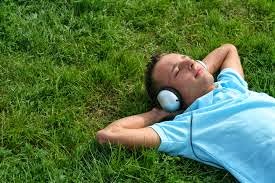If you're in pain, you may be able to harness your thoughts
to help fight it. Skeptical? Studies suggest these
pain relief tools can work.
Some techniques work for short term (or acute) pain, others
for chronic pain. Either way, here are 12 methods to try.
Food fantasies
Thinking about food—whether it's warm, gooey chocolate
brownies or a juicy roast beef meal—has been shown to help alleviate pain from
menstrual cramps, migraines, and more.
A study conducted by University of Wisconsin researchers
found that fantasizing about a favorite food took away some of the pain
associated with plunging a hand in icy water (a pretty painful process used in
research).
Chocolate was the favorite food fantasy, preferred by 32% of
participants in the study, followed by a roast dinner (31%), pasta (14%), pizza
(14%) and fruit (4%).
Meditation
Meditation
Meditation may be one of the most powerful tonics for pain.
 One 2011 study found that mindfulness meditation, which
focuses on the breath, reduced pain intensity
One 2011 study found that mindfulness meditation, which
focuses on the breath, reduced pain intensity Controlled breathing
You don't have to be an expert meditator to reap the
benefits of breathing. Practicing deep, diaphragmatic breathing (that's
breathing from the belly rather than shallow inhaling and exhaling from the
chest) can be very helpful, says Singles, who is a distinguished psychologist
in orthopedics and rehabilitation at the University of Wisconsin.
Distraction
Focusing elsewhere means the pain isn't hogging all your
attention. This could simply be focusing on other parts of the body one at a
time to induce progressive relaxation or another activity such as reading or
watching a movie.
"Positive distractions are very helpful because the
more you focus on pain guaranteed the worse you're going to feel," she
says.
Saying a mantra
Saying a mantra
As little as 30 seconds of using a mantra can dampen
unpleasant sensations, says Ellen Slawsby, PhD, director of Pain Services at
the Benson Henry Institute at Massachusetts General Hospital in Boston. Slawsby
recommends a picking neutral or positive word or phrase rather than a sound.
Visualization
imagine yourself on the beach or seeing your worries melt
away. "The key is knowing what kinds of things are relaxing for you and
envisioning that can be helpful," says Slawsby. "Visualization can be
great for arthritis patients to ease joint pain."
You can imagine you're in a warm bath with hands floating on
the water. "Go through the whole imagery of going into the tub, your toes,
ankles, knees, hip joint, lower back, middle back, shoulders," she says.
"Imagine the joints being warm and relaxed without the pressure of the
regular planetary pull because you're in the water. It gives you a
buoyancy."
Activating pressure points
Activating pressure points
Also known as self massage, applying pressure to areas that
hurt, especially if it's a tension headache or muscle pain, can be very
beneficial, says Slawsby. It's not clear why it works but it does.
Some people think that soothing messages from the massage
counteract pain messages. Or it could be that the pressure reduces muscle
tension, which is the culprit behind many different types of pain.
Positive thinking
Try to switch to more positive thoughts and, in particular,
avoid catastrophizing or imagining the worst.
Listening to music
Music can provide a welcome distraction, but also offers so
much more. One study, which looked at
rheumatoid arthritis patients and others
suffering from chronic pain, found that listening to music for one hour over
one week subdued pain, depression, and disability while increasing feelings of
power. Writing
Getting your thoughts and feelings on paper has been shown
to relieve pain in many different populations. It can even enhance immune
function. James W. Pennebaker, PhD, a leading researcher in the field,
recommends writing before bed for a minimum of 15 minutes a day for at least
three or four days.
Some possible topics: Something that you are thinking or
worrying about too much, something you've been avoiding, or something you think
is affecting your life in an unhealthy way.
Tapping into your creativity
Tapping into your creativity
Art therapy is gaining more credibility in medical settings,
with some hospitals having dedicated therapy—often geared to children.
But the technique works in adults as well, with one study
reporting that one hour of art therapy relieved physical and psychological
symptoms in people living with HIV/AIDS.
The same group of researchers earlier found that playing
with clay, glitter glue, yarn, beads, colored pencils, and an array of other
art supplies relieved symptoms of pain and anxiety in cancer patients.
Laughing
Laughing
The adage "laughter is the best medicine" is no
joke. A pilot study conducted at UCLA found that children and adolescents who
watched humorous videos while their hands were soaking in frigid water were
better able to tolerate the pain.
Another study attributed the effects of laughter on the
release of endorphins, nature's own analgesic.
Source : swansonvitamins.com


Comments
Post a Comment